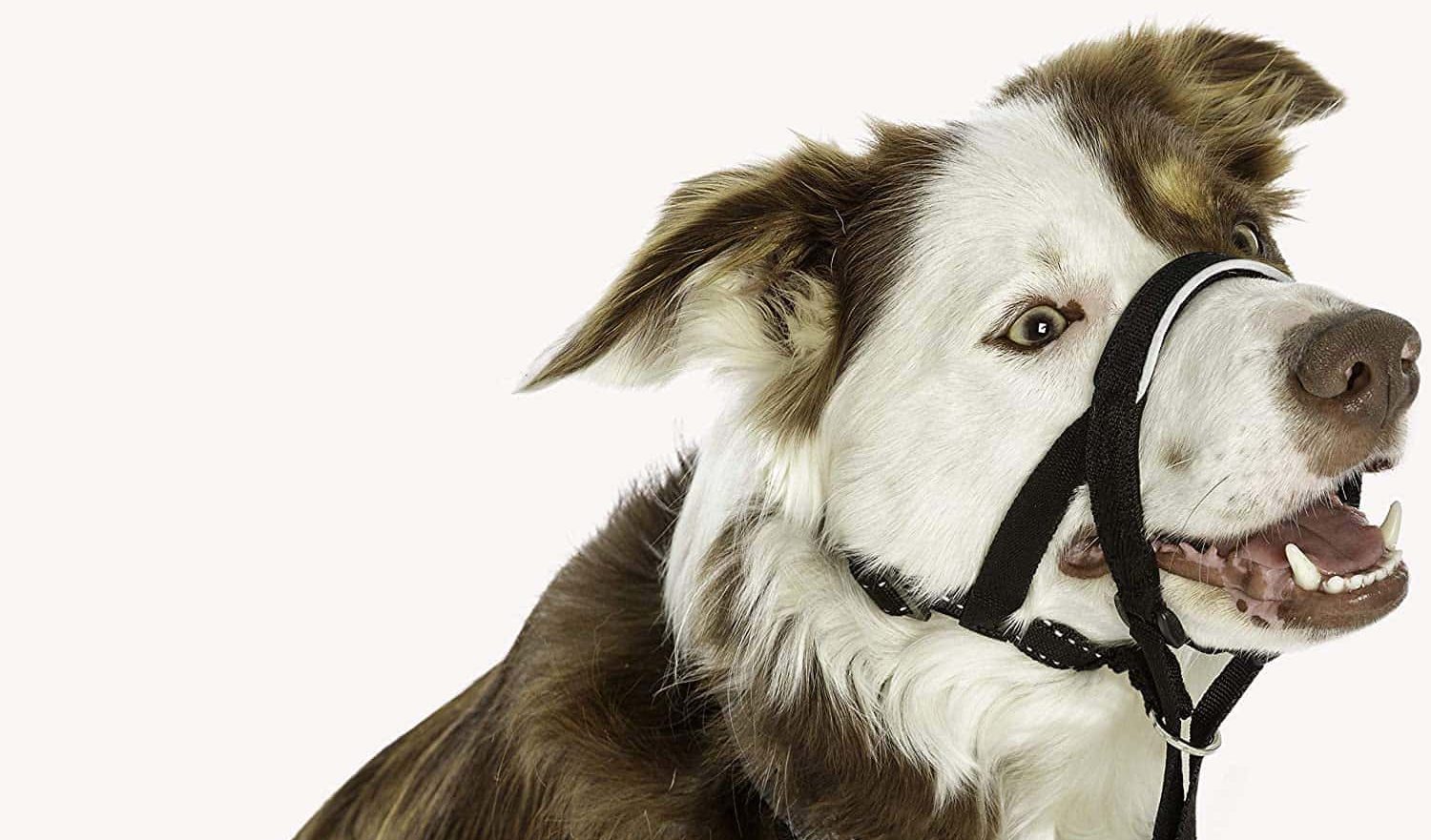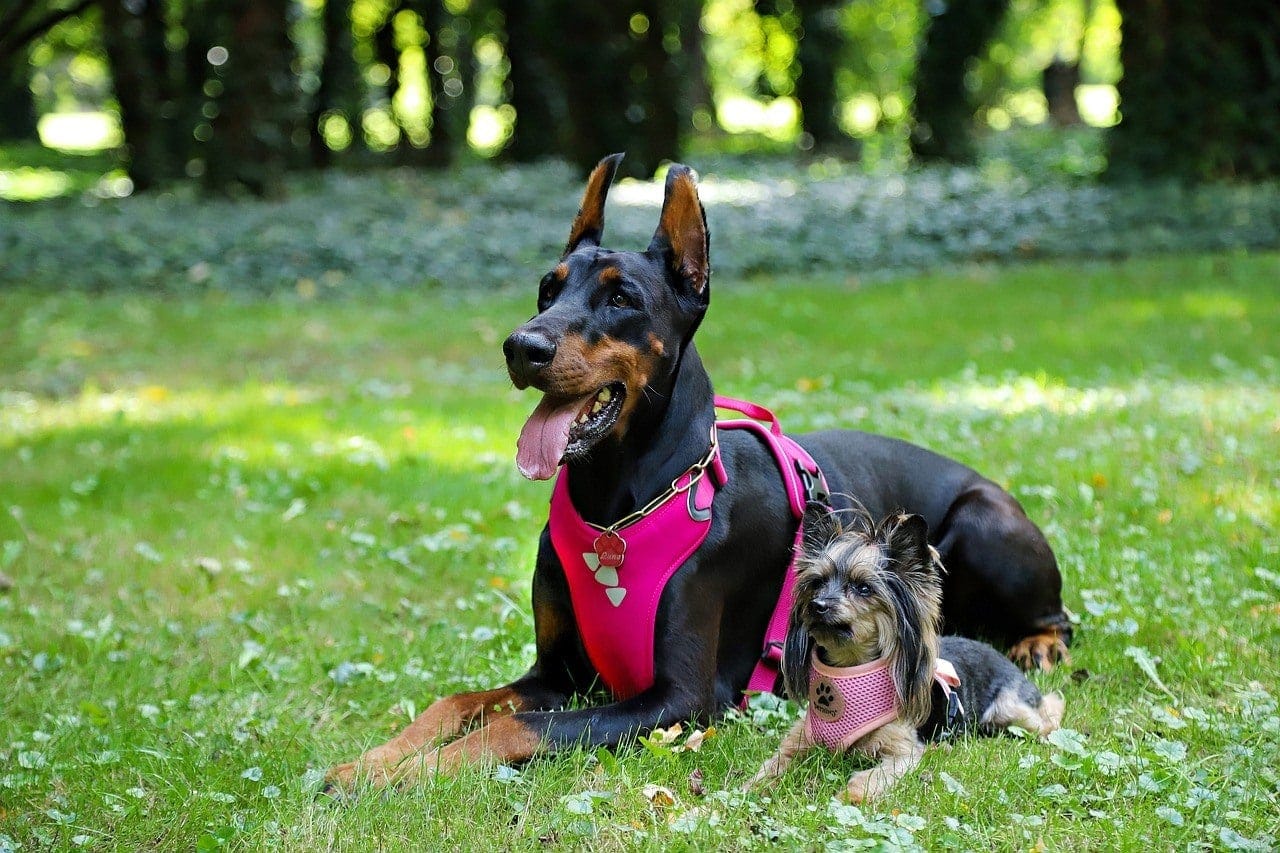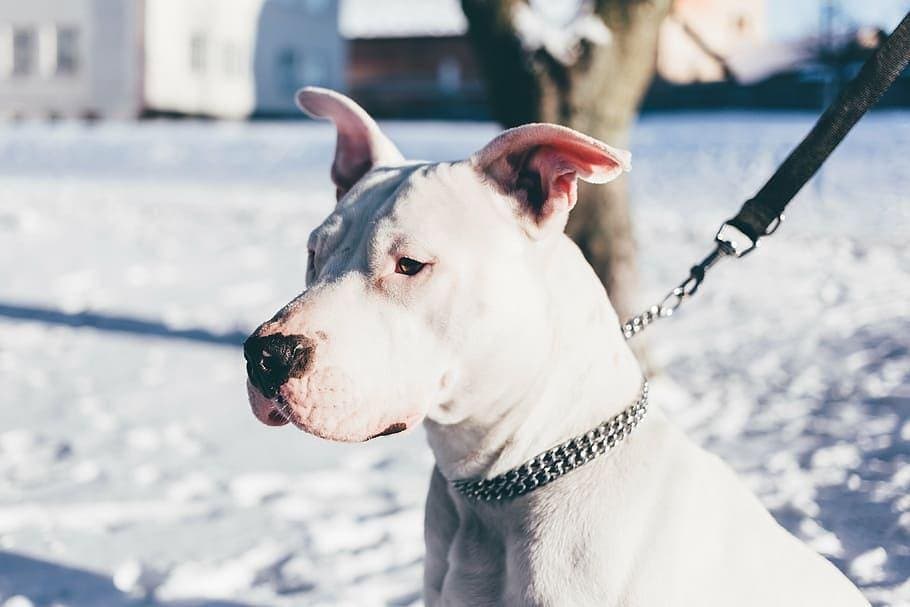Head Dog Collars or Head Halters

Head collars, also known as head halters, are especially helpful for keeping your dog focused on walking straight ahead. It slips over your dog’s snout and attaches behind the ears. Ideal for gently training your dog to walk without pulling, this style of collar redirects your dog’s attention, as it essentially points your dog’s head in the direction you want to go. By nature, where the head goes, the body follows.
As you walk, you can easily train your dog that a taunt leash means “stop.” The benefit of a head collar or head halter is that eventually, your dog will learn to walk with a loose leash and be less distracted. As a result, this type of collar may have a calming effect on your dog.
Since this collar attaches to the snout, you may initially have difficulty convincing your dog to allow you to put it in place. Many owners have success using treats as an incentive. Once the collar is in use, be aware that it tends to rub the fur on your dog’s face, which may cause irritation. For this reason, your dog may try to remove it by pawing at it or rubbing their face on the ground.
One last important consideration with a head collar: Take care to not harshly jerk your dog’s head around. If your dog suddenly takes off at full speed and comes to the end of the taut leash, the setup of this collar can cause severe injury.

Designed to reduce tension on your dog’s neck, a harness slips around your dog’s front legs and snaps closed behind the upper part of your dog’s back. With a little training, your dog may step into the harness directly. Then you snap it together and clip the leash to either a clip located on the chest or the back. Certain harnesses can give you both options.
If you own a short-nose breed, such as a pug or a Boston terrier, a harness is your best option for restraint. Miniature poodles, who tend to have trachea issues, can also greatly benefit from using a harness over a neck collar.
Keep in mind that without neck tension to act as a deterrent, your dog may pull and lunge more vigorously. Attaching your leash to a front clip harness can allow you to regain control by redirecting your dog’s attention toward you. For even greater control, opt for a harness with a specially designed dual leash that attaches to both the front and back clips simultaneously.
Although you may be avoiding harmful neck tension with a harness, it’s not without its safety concerns. With frequent pulling, your dog’s back may be strained or sustain an injury.

+ FREE Shipping on Pet Food and Supplies
Slip Collar or Choke Chain

As your dog pulls, the slipknot design of a slip collar or choke chain tightens around your dog’s neck. The tightening sensation should alert your dog to stop lunging and pulling. As with all neck collars, choking becomes a hazard, and the slip design also creates opportunity for neck and trachea damage. However, with professional training, a slip collar can help your dog walk without tension on the leash.
Slip collars and choke chains are most often used with strong, untrained dogs. These collars prevent dogs who may be a danger to others or themselves from escaping and help them to be better controlled.
#6 Harnesses (aka: body harnesses): While these “collars” are humane and are perfect for a dog with health issues in the neck area, they can actually encourage a dog to pull on the leash and lessen the control a handler has over a dog. Simply stated, there’s a reason that harnesses used on dog sleds are very similar to these harnesses – they make it easy for a dog to pull.
#8 Prong Collars (aka pinch collars): The idea behind these collars is that a dog will fully understand that to stop the pain, he must stop pulling on the leash – many dogs don’t figure this out. These collars frequently cause a dog to hurt his neck (specifically his trachea) and can really frustrate him. There really is no place for these collars in my opinion.
#9 Shock Collars (aka eCollars): Anything that can fix problems with a push of a button just has to be too good to be true. Shock collars might appear to fix behavioral issues in some cases, but they frequently cause significant additional long term problems. Please do not ever use these.
#1 Flat Collars, Buckle: As is true with so many things in life, the most old fashioned and simple of all dog collars is the best. They got it right the first time. Since this collar is flat, it is less dangerous to a dog’s trachea. Because it uses a buckle, it doesn’t slip. Voila! Available in all pet supply stores in nylon or leather. If your dog is reasonably well behaved, take him to the pet supply store for proper sizing.
#3 Rolled Collars: This collar is normally made from a strip of leather that has been rolled into a tube shape. These collars are great for dogs with long fur because they don’t mat the fur as much as a standard flat collar. My only gripe with these collars is that they are small in diameter which can be painful to a dog in some circumstances.
Prong Collar vs Flat Collar Pressure on Dog’s Neck – Robert Cabral Dog Training Video
Our mission is to help save dogs and cats’ lives through our educational content. To support our efforts, this page may contain affiliate links. We earn a commission for qualifying purchases – at no cost to you.
As Preventive Vets dog behavior expert and lead trainer at Pupstanding Academy, Cathy focuses on helping humans and their pets build a strong relationship based on trust, clear communication, and the use of positive reinforcement and force-free methods. With over 13 years of experience, she has had the opportunity to work with hundreds of dogs on a wide variety of training and behavior issues. Beyond her one-on-one consultations through Pupstanding Academy, she also teaches group dog training classes at Seattle Humane. Her specialties include dog aggression, resource guarding, separation anxiety, and puppy socialization.
Cathy is certified through the Certification Council of Professional Dog Trainers, holding both the CPDT-KA and CBCC-KA designations. Cathy is a Fear Free Certified Certified Professional, a member of the Association of Professional Dog Trainers, the Pet Professional Guild, and the Dog Writers Association of America.
When shes not geeking out about dogs, you can find her reading, hiking with her two Cardigan Welsh Corgis, or paddleboarding.
A note for our readers: If you have an urgent question and are unable to ask your veterinarian, you can use the Ask a Vet service that will give you access to a veterinarian for 7 days for $1.